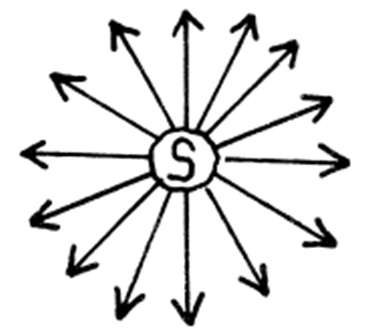![]() The third step in the decision-making process is to develop all the possibilities for reaching your goal. Since decision-making involves choosing among alternatives, you need to know what your options are before you can select your choice. At this stage, don’t eliminate any possibilities!
The third step in the decision-making process is to develop all the possibilities for reaching your goal. Since decision-making involves choosing among alternatives, you need to know what your options are before you can select your choice. At this stage, don’t eliminate any possibilities!
The symbol we use for developing the possibilities is a wheel. The situation is represented by the circle, the goal is the target, and the possibilities are the spokes.

Shown here is the original symbol for step three used in the 1972 edition of the Thresholds Manual by Burglass.
The accompanying caption reads:
” Surrounding every situation, there are 3600 of possibility, all equally valid.”
Mickey Burglass, the founder of the Thresholds teaching system for rehabilitating prison inmates, had a knack for simplifying (and disguising) the profound conclusions of philosophy and psychology. The ABC’s of discovery on the right hand column are an excellent example.
When we teach these ABC’s we are, in effect, explaining the only three ways the human learns anything, the basic tools of all education: Perception, reasoning & authority.
- Sense perception.
“Nihil in intellectu nisi prius in sensu.”
Nothing in the intellect unless first in the senses.
- Reasoning.
—Deductively, from general to specific; from cause to effect
The comparison of two judgments leading to the inference of new knowledge in a third judgment.
A = B
B = C
Ergo: A also = C
–Inductively, from specific to general, from effect to cause
It sees every time it rains the dirt turns to mud..
I think if it rains to day, the dirt will get muddy.
- Authority of others.
Books, lectures, Internet, advice of informed people we trust and respect.
Techniques for helping clients develop a list of possible ways to reach a goal employ the ABC acronym.
A…Accumulate information. Gather facts from friends, books, tapes libraries, agencies, schools, etc.
B….Brainstorm. List everything that comes to mind. Don’t make any judgments. Just generate items, alone or with the help of others.
C….Consider or reflect on unique approaches and new combinations…Sleep on it. Take it up again.
 One of the teaching aids used to help clients “think outside the box,” while developing possibilities is the 9-dot, 4 line puzzle.
One of the teaching aids used to help clients “think outside the box,” while developing possibilities is the 9-dot, 4 line puzzle.
ON A SEPARATE PIECE OF PAPER, NOT THE PC SCREEN.
Try to connect all 9 dots with only 4 straight lines, without lifting your pencil from the page! Answer at bottom of this web page.
There are, however, certain blocks that hinder our search for possibilities. They are the JAM blocks
Jumping to conclusions, reacting with out thought.
Again and again…doing the same thing the same old way
Myths…Stories based on false beliefs, self-doubt and intolerance.
Students of logic and persuasive writing courses will recognize these three roadblocks as a partial list of the logical fallacies in thinking.
